Scotch Macaskill's Wildlife Blog
IMPORTANT: Please note that from April 2009 this Blog's Web address changed as a result of a switch in the blogging platform we use. It's still an integral part of the Wildlife Pictures Online website and, we hope, will continue providing entertaining and enjoyable content in the form of wildlife images, news, views and information.
For the most recent posts, links, and other resources, please visit the new Wldlife Photography Blog.
|
Today's Picture: Glossy Starling on Aloe
November 2, 2008
|
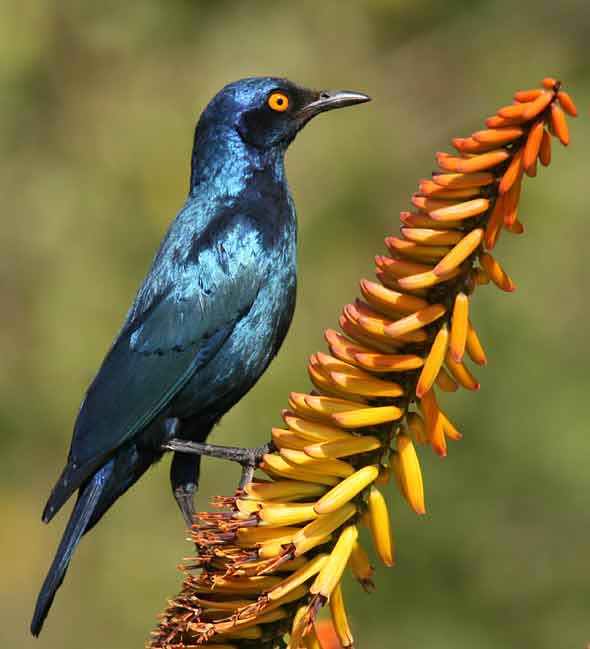 Photo Details: Glossy Starling (Lamprotornis nitrens) on flowering aloe, Elephant Plains Game Lodge, Sabi Sand Game Reserve, South Africa.
Photo Details: Glossy Starling (Lamprotornis nitrens) on flowering aloe, Elephant Plains Game Lodge, Sabi Sand Game Reserve, South Africa.
Camera: Canon EOS 400D (Digital Rebel XTi); Lens: Canon EF 600L F4 USM + 1.4x converter; Focal Length: 840mm; Shutter speed: 1/000; Aperture: f5.6; ISO: 400.
Additional Info: Canon's EF 600mm F4 super-telephoto is a monster lens and scary to use, specially when it's not your own.
In this instance I was using it on a Manfrotto tripod with tilt-and-pan head, which means you have to make sure the tilt adjustment is tightly secured.
If you don't - and you take your hands off the camera - the lens will drop from horizontal to vertical in a flash and possibly even pull the entire tripod down if the latter is not in a stable position. But once you get the hang of using the lens, it's quite spectacular - incredibly fast focusing and amazingly sharp, even with a 1.4x converter (provided of course you keep it steady as a rock).
In June this year Canon added the EF 800mm F5.6 to their line-up of super-telephotos. At 9.9 lbs / 4.5 kg it's actually slightly lighter than the 600mm (11.82 lb / 5.36kg), thanks to a magnesium alloy body and mount. But you'll need to mortgage the house to buy one - recommended retail price is $11,999.00, although you'd probably get it for about a grand less if you shopped around.
|
Winning Wildlife Picture Taken with Remote-controlled Camera
November 5, 2008
|
The Overall Winner of this year's Wildlife Photographer of the Year is Steve Winter of the USA. Interestingly, his winning entry, titled "Snowstorm leopard", was taken with a remote-controlled camera.
Steve, a photographer for National Geographic magazine, spent 13 months on the project, working in the harshest of conditions at altitudes of 13,000 ft in India's Hemis High Altitude National Park. He used 14 remote cameras, set up in 45 locations.
There's a full account of what was involved in capturing the elusive subject, including the photographer's dilemma about using remote-controlled cameras, on the United Photo Press Blog,
The Young Photographer of the Year prize went to British teenager Catriona Parfitt for her shot of a lion harassing a giraffe at a waterhole in Namibia.
Catriona used a Canon EOS 400D digital SLR with a Canon EF300mm f4 IS USM lens + Canon EF 1.4x converter, a wildlife photography lens set-up I have previously recommended.
The competition, now in its 44th year, is run by BBC Wildlife magazine and London's Natural History Museum.
|
Today's Picture: Zebra, Front-On View
November 10, 2008
|
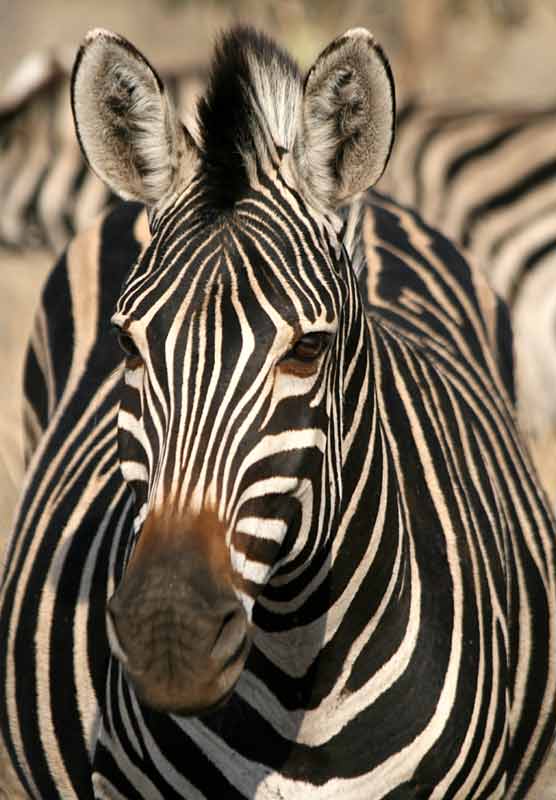
Photo Details: Front-on view of a Burchells' zebra (Equus quagga), Kruger National Park, South Africa.
Camera: Canon EOS 400D (Digital Rebel XTi); Lens: Canon 70-300 F4-5.6 IS USM; Focal Length: 210mm; Shutter speed: 1/2000; Aperture: f5; ISO: 400.
Additional Info: One of the more descriptive collective nouns for a group of zebras is a "dazzle" of zebras. Others are a "zeal", a "cohort" and, of course, the common "herd" of zebras. I like dazzle, as it aptly describes the constantly shifting visual display that can bewilder and confuse the viewer as the animals mingle and move around.
This provides both a challenge and an opportunity when taking zebra pictures. The challenge is to produce an image that's not a jumbled blur of stripes with no point of interest or focus, while there are opportunities aplenty to experiment and try to blend or juxtapose the stripes to best effect.
I'm not sure if the above image is too confusing, but it offers an interesting array of patterns, while the animal's eye does provide a point of focus - from which there are numerous lines the human eye can follow.
For this shot I used the relatively inexpensive Canon 70-300mm image-stabilized zoom (inexpensive compared to "L" series lenses, that is). It's lightweight, easy to hand-hold, the IS works well, and is a good choice as a starter lens for wildlife photography.
|
Art for Good Causes
November 14, 2008
|
Today I'd like to mention two art-related websites, both aimed at raising money for worthy causes.
The first, Art for Chimps, is the brainchild of Australian wildlife artists Patrick Hedges (centre) and Leigh Rust (right), seen below with Dr Jane Goodall.
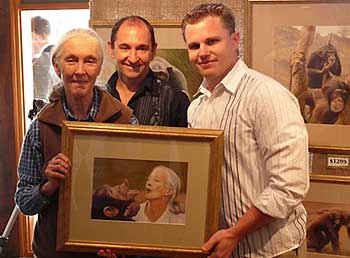
October saw the official opening of their Tears of Leaves art exhibition at Monarto Zoo in Adelaide, Australia. The exhibition, which runs until the 19th of December 2008, was opened by renowned primatologist Dr Jane Goodall and coincided with the opening of the zoo's new chimpanzee habitat.
The works on display, featuring mainly chimpanzees but also other wild animals, are being sold to raise funds for Monarto Zoo and Tacugama Chimpanzee Sanctuary in Sierra Leone.
With the backing of Dr Goodall, the artists are determined to raise awareness about the plight of chimpanzees and great apes in general.
Both are founding members of the Untamed Artist Network, a dedicated group who use their work to help with conservation of wildlife.
The second site, Art4charity, features the work of up and coming South African artists.
Although the subject matter of the pieces displayed on the website is fairly diverse - from still life to portraits - there is a strong emphasis on nature and the South African landscape. By international standards and at current exchange rates the works are very affordable.
All sales will benefit two educational organisations helping and teaching children of underprivileged, unemployed parents, both local South Africans and refugees from neighbouring countries. The two charities supported are Butterfly Way Educare in Vrygrond, Capricorn, Muizenberg, Cape Town, and Capricorn Primary School, Vrygrond, Muizenberg, Cape Town.
|
Today's Picture: Lioness with Cubs
November 20, 2008
|
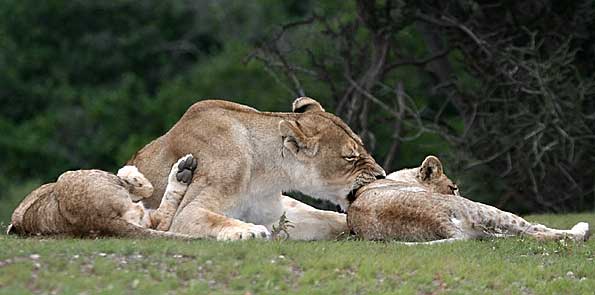
Photo Details: Lioness (Panthera leo) grooms her one cub while the other dozes contentedly next to her, Mashatu Game Reserve, Tuli Block, Botswana.
Camera: Canon EOS 350D; Lens: Canon EF 100-400mm f/4.5-5.6L IS USM; Focal Length: 200mm; Shutter Speed: 1/200; Aperture: f/5; ISO: 800
Additional Info: For the above image I used Canon's 100-400mm image-stabilized (IS) zoom. It was already late and the light was poor, so I had to
push the ISO to 800 to ensure a reasonably fast shutter speed.
Even with IS, camera shake can be a problem at slower shutter speeds.
Zoomed to 200mm, the maximum aperture of this lens is F/5, so boosting the ISO was the only way to increase shutter speed.
If I'd been shooting wide-open with a 70-200m F/2.8, I could have used 400 ISO and a shutter speed around 1/500. It's in these situations that the "fast"
lenses with big maximum apertures are so useful. But the 100-400 is nevertheless a very versatile zoom lens for wildlife photography with a loyal following.
|
Today's Picture: Baboon in Field of Flowers
November 25, 2008
|
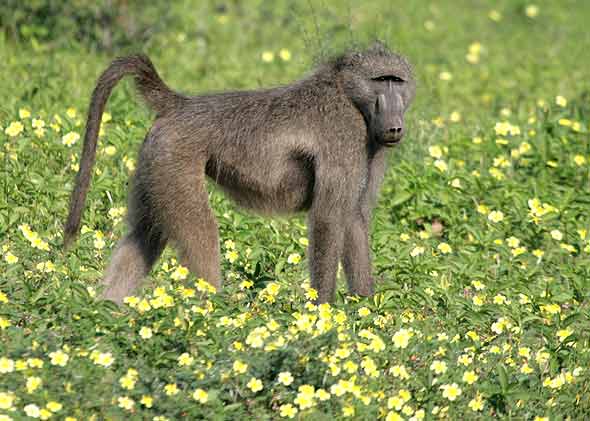
Photo Details: Chacma baboon (Papio ursinus) standing on all-fours in a field of flowering devil's thorn or "duiweltjie" (Tribulus zeyheri), Mashatu Game Reserve, Tuli Block, Botswana.
Camera: Canon EOS 400D; Lens: Canon 100-400 IS Zoom; Focal Length: 400mm; Shutter speed: 1/1600; Aperture: f5.6; ISO: 400.
Additional Info: The "duiweltjie" or devil's thorn, with its yellow flower that blooms and produces seeds within two weeks of rain, adds a spectacular yellow pattern to the Tuli Block's post-rain greenery. The photo above was taken in April, towards the very end of summer and the rainy season.
Tomorrow I'll be visiting Mashatu for a week, and it's very probable that we'll see the flowers at this time of the year as well. National Geographic's WildCam Africa is still operating
at Pete's Pond in Mashatu and, on the WildCam Africa website, there is the following update:
"19 Nov 2008: The wet season is on its way to Botswana! The rain and wind affect the microphone and we are currently covering it in plastic when it is wet which is changing the sound at those times."
|
| |
| Back to top of page
|
|
Previous Entries
By Month
By Category
My Original Blog
2005 Entries
2004 Entries
2003 Entries
Who Am I?
Brief Bio
|

 Photo Details: Glossy Starling (Lamprotornis nitrens) on flowering aloe, Elephant Plains Game Lodge, Sabi Sand Game Reserve, South Africa.
Photo Details: Glossy Starling (Lamprotornis nitrens) on flowering aloe, Elephant Plains Game Lodge, Sabi Sand Game Reserve, South Africa.



